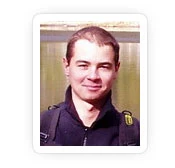Revolved Half Moon Pose: 3 Steps to Lift and Stabilize the Pelvis

You can learn a great deal about biomechanics by examining how the body responds to pathological conditions. In this post, I examine what happens with the pelvis when the hip abductors are not functioning properly. Then I illustrate how to use this knowledge to refine asanas like Revolved Triangle (Parvrtta Trikonasana) and Revolved Half Moon (Parvrtta Ardha Chandrasana).
Safe Cuing for Revolved Half Moon Pose
Balancing the pelvis is a key factor in normal gait as well as yoga poses. Conversely, persons with weakness in the hip abductors develop what is known as a “Trendelenberg” gait, where the pelvis tilts up and shifts toward the affected side during the stance phase of walking. A variety of conditions can affect the hip abductors, including hip pain (from arthritis) and injury to the nerve supply of the gluteus medius.
In medicine, we test the function of the hip abductors by having the patient stand on one leg in the “Trendelberg Test.” When the muscles are competent, they automatically engage to draw the pelvis level; when the muscles are weakened, the pelvis on the standing leg side lifts (while the lifted leg side sags downward). At the same time, the spine curves toward the affected hip, with the shoulder girdle tilting towards that side. Figure 1 illustrates the Trendelenberg Test. Note how the pelvis tilts and the spine laterally flexes when the gluteus medius does not engage properly.

(Figure 1: The Trendeleberg Test; Image on the left illustrates the gluteus medius engaging to stabilize the pelvis. Image on the right illustrates pelvic tilt and lateral spine flexion with the dysfunctional gluteus medius.)
The spine compensating for the tilt of the pelvis is an example of lumbar-pelvic rhythm.
Now, let’s look at how we can apply this knowledge to help lift the back leg in Revolved Half Moon Pose. I begin by training awareness of the abductor muscles (especially the gluteus medius) in Revolved Triangle Pose. The cue for this is to fix the forward foot on the mat and attempt to drag it to the outside, while resisting with the hand. You will note that this helps to bring the pelvis in line with the rest of the body. Figure 2 illustrates the preparatory poses for this asana and Figure 3 illustrates the cue.

(Figure 2: Preparatory poses for Revolved Triangle Pose.)

(Figure 3: Engaging the hip abductors in Revolved Triangle Pose.)
Next, I use sequential muscular engagement to lift the back leg in Revolved Half Moon Pose, beginning with the hip abductors of the standing leg. Engaging these muscles acts to lift, rotate and stabilize the pelvis on the side of the lifted leg (in a fashion similar to what we learned with the Trendelenberg Test). Then I engage the muscles that lift the leg itself, including the gluteus maximus and its synergists of hip extension (the hamstrings and adductor magnus). The gluteus maximus contracts eccentrically.
Finally, I use the quadriceps to straighten the knee. Figure 4 illustrates the preparatory poses for Revolved Half Moon Pose. Figures 5 and 6 illustrate engaging the hip abductors in the standing leg to lift the side of the pelvis for the raised leg. Figure 7 illustrates the final step—engaging the hip extensors and the quadriceps of the raised leg. Work with a chair or block to gain stability if you are new to the pose.

(Figure 4: The preparatory poses for Revolved Half Moon Pose.)

(Figure 5: Engaging the hip abductors to lift the pelvis on the side of the raised leg.)

(Figure 6: Engaging the hip abductors to lift the pelvis on the side of the raised leg.)

(Figure 7: Engaging the hip extensors of the raised leg (gluteus maximus, hamstrings, adductor magnus) and knee extensor (quadriceps).)
Note that the deep external rotators of the standing leg also facilitate stabilizing the pelvis in Revolved Half Moon Pose. Figure 8 illustrates these muscles.

(Figure 8: The deep external rotators stabilizing the pelvis in Revolved Half Moon Pose.)
These steps are an example of anatomic sequencing for yoga. Each muscle group is engaged in a specific order to achieve optimal form and stability.
Printed with permission from dailybandha.com
 Author, Ray Long MD, FRCSC is a board certified orthopedic surgeon and the founder of Bandha Yoga. Ray graduated from The University of Michigan Medical School with post-graduate training at Cornell University, McGill University, The University of Montreal and Florida Orthopedic Institute. He has studied hatha yoga for over twenty years, training extensively with B.K.S. Iyengar and other leading yoga masters.
Author, Ray Long MD, FRCSC is a board certified orthopedic surgeon and the founder of Bandha Yoga. Ray graduated from The University of Michigan Medical School with post-graduate training at Cornell University, McGill University, The University of Montreal and Florida Orthopedic Institute. He has studied hatha yoga for over twenty years, training extensively with B.K.S. Iyengar and other leading yoga masters.

3d Graphic Designer / Illustrator Chris Macivor has been involved in the field of digital content creation for well over ten years. He is a graduate of Etobicoke School of the Arts, Sheridan College and Seneca College. Chris considers himself to be equally artistic and technical in nature. As such his work has spanned many genres from film and television to videogames and underwater imagery.




